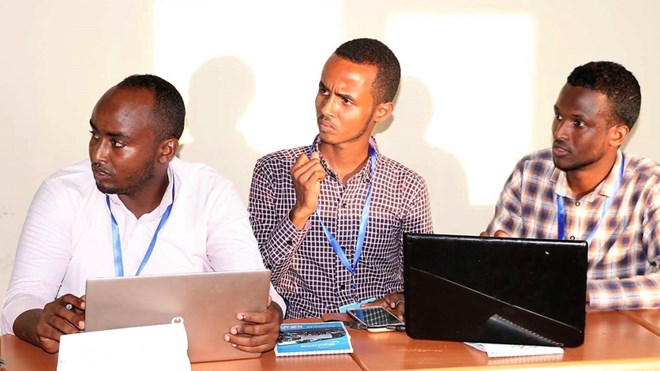
Friday July 10, 2020
By ROKU FUKUIABDULLAHI BIHI HUSSEIN

Somali students group. Photo: Somali Network Operators Group (SomNOG)
In Somalia, located in the Horn of Africa, and one of the most conflict-affected parts of the world, battling the COVID-19 pandemic has been an ordeal. With 2,835 confirmed cases as of today (but many more unconfirmed), Somalia had to make the most out of its meager resources to tackle the pandemic while also fighting a locust invasion. To help contain the pandemic, the Ministry of Education, Culture and Higher Education (MOECHE) decided to suspend all classes, as overcrowded classrooms present an obvious health risk, at least until the situation improves. As universities scrambled to figure out what to do - the Somali Research and Education Network (SomaliREN) stepped in to deliver education over the internet. A considerable challenge in a country where less than 10% of the population has access to the internet.
The effect of the pandemic is felt harshly in the education sector in Somalia as universities are privately funded and rely on tuition fees structured around semester enrolment, mid-terms and final exams, which often also cost a fee. To ensure continuity of operations and avoid major disruptions, SomaliREN, a national research and education network established in 2009 by six Somali universities and owned by its member institutions, explored alternative approaches to deliver lectures online through virtual classrooms.
Digital transformation is at the heart of the Network’s mission and SomaliREN has been striving for a future in which Somali schools have high-speed digital connectivity. Its main focus is to improve access to affordable, high-speed connectivity on campus for its member institutions, the faculty, and students. SomaliREN has connected 20 institutions, which translates to 50 campuses. These institutions are connected to three different zonal PoPs (point of presence) and international capacity is now 310 Mbps for the area around Mogadishu, the capital. Not only does SomaliREN provide internet access and local connectivity (connecting university campuses to the resources at the SomaliREN data center), it also now offers video-conferencing facilities, collocation and server hosting for the member institutions, virtual training labs, and capacity building, among other services. Of the 20 member institutions, seven of the members have rolled out free campus WiFi for the students. Most graduate programs have had some element of blended learning mode of delivery. The rollout of connectivity across member institutions was completed with the support of the World Bank Group and the Ministry of Post, Telecommunications, and Technology (MPTT).
But COVID-19 proved to be another challenge as universities had to move graduate programs online in record time. Experts and professors are being recruited from abroad to teach courses and students are expected to be admitted from beyond the institution’s borders, with a large population of the Somali diaspora enrolling to learn Arabic or courses taught in Somali. There is no proximity requirement online, which allows students to get instruction for a fee from the best teachers – and teachers to provide learning, no matter where they reside. With the directive to suspend all classes, SomaliREN rushed to take the platform to production phase and invited universities to take advantage of this solution. Now, 11 member universities out of the 20 current members use the platform to deliver their classes online, while the remaining institutions train their faculty members on the adoption of the system. The platform, running on two servers donated by the World Bank in December last year, was initially implemented as part of a project to connect Somali professors and lecturers in the diaspora to Somali universities and reverse the brain-drain that resulted from the prolonged conflict in the country. It end up being a useful tool that has enabled universities to respond to the COVID-19 emergency, though, the scalability of the platform to meet growing demand is a challenge.
Digital transformation in the Somali higher education institutions has been a work in progress for the past decade. However, there are still challenges, including access to network devices (mobile phones and computers), access to connectivity at homes, and the will of local operators and service providers to zero-rate education and research traffic. If we are to build a future economy and education system based on remote learning, we need a connected population and strong digital infrastructure. For innovative educational technology solutions to be effective, the government and the private sector must make investments to convert the nation’s digital infrastructure to cloud-based platforms and digital infrastructure. Well-informed higher education and telecommunications policies are required as well, such as those to increase connectivity in hard to reach areas and regulatory practices to involve the private sector. By doing its best to keep the students connected, a program like SomaliREN shows the need for the country to accelerate its digital transformation.